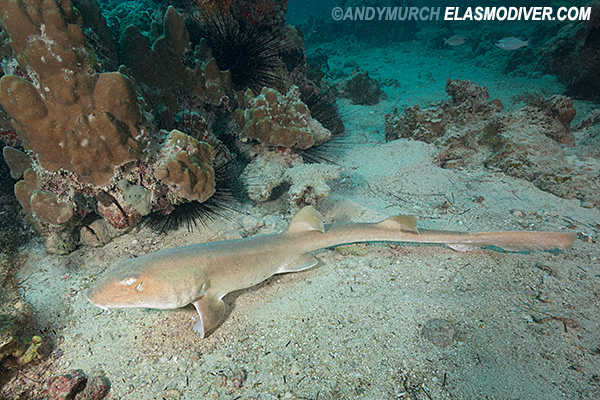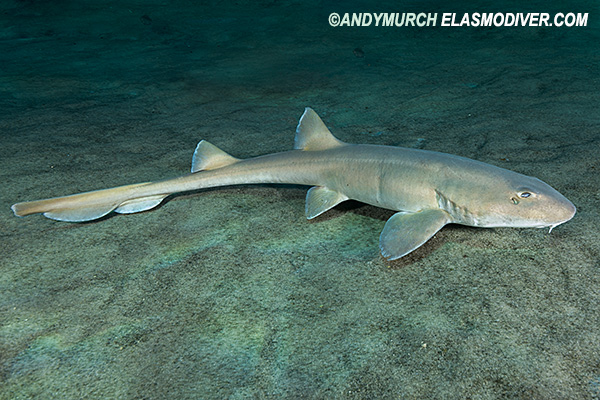|


View more
Arabian
Bamboo Shark images
in the
Shark Pictures Database
Common
Names:
Arabian bamboo
shark.
Latin
Name:
Chiloscyllium arabicum
Family:
Hemiscyllidae
Identification:
Elongated, mostly unmarked tan/brown body.
Well defined lateral groove on each flank running
from behind head to base of tail.
Occasionally, older animals may have a
few scattered small dark or pale spots on head, torso and fins.
Dorsal fins relatively large with
straight or mildly convex rear margins. First dorsal origin over pectoral fin
base (not over pectoral fin insertion). Anal fin set far back at base of tail. Snout
blunt. Barbells extend
from nares to mouth. Spiracle slightly smaller than, and positioned below and
slightly behind eye. Short gill slits.
Size:
Maximum length 70cm. Less than 10cm at birth. 45-54c at maturity.
Habitat: Coral
reefs, reef rubble patches, rocky shorelines and mangrove flats.
From 3-100m.
Abundance
and distribution: Indo Pacific. Northwest
Indian Ocean. Persian/Arabian gulf to western India. Exact limits of range are
in question due to confusion with the grey bamboo shark H.griseum.
Behavior: Nocturnal.
Rests
by day in
crevices on the reef or under corals.
Diet:
Feeds on
squid, shelled mollusks, crustaceans and snake eels.
Reproduction:
Oviparous.
Deposits four egg cases at a time on the reef. Eggs hatch after 70-80 days.
Conservation Status:
Considered 'Near Threatened' by the IUCN. The Arabian Carpetshark (Chiloscyllium
arabicum) is not targeted but appears to be a major bycatch element of trawl
(and other) fisheries. Apparently it is little utilized in the Persian Gulf but
probably it is used in Pakistan and India. It is reasonably hardy to trawl
capture and aerial exposure but is also threatened by habitat loss throughout
its range. This species is known to have close association with coral reef
habitats, which are particularly prone to anthropogenic degradation and there is
evidence that such habitats have been completely destroyed from some parts of
its range (e.g., Bahrain). More generally, it is exposed to widespread habitat
loss and modification, not least in the Persian/Arabian Gulf (drainage of Iraqi
marshes and damming of rivers in Turkey affecting the northwest Gulf), coastal
developments and effects to benthic communities from demersal trawling
throughout much of its range. It is also known to accumulate organic pollutants
such as PAHs. The threats of fishing and habitat degradation are likely to
continue into the future and increase in intensity and coverage. As a result of
these combined factors, this species is assessed as Near Threatened based on
inferred continuing population declines approaching 30% in three generations
(possibly ~27 years). Given that a proportion of discards may have a relatively
high survival rate, a threatened category is not yet warranted, but the species
may meet the criteria for VU A4bcd in the future. There is a need for
quantitative distribution and abundance data.
Photographs:
Abu Dhabi, UAE.
Similar species:
The Arabian bamboo shark partially shares its range with a number of other bamboo
sharks, one of which looks very similar. The grey bamboo shark Chiloscylliam
griseum has dorsal fins with straight or concave rear margins. The first
dorsal origin is roughly level with the pectoral fin insertions.
Reaction to divers: Reasonably easy to
approach with slow casual movements but will bolt if
mollested.
Diving
logistics: Arabian bamboo sharks are
regularly seen by divers in the UAE. Contact Al Mahara Divers
http://www.divemahara.com for more info.
Citations:
Moore, A.B.M. 2009. Chiloscyllium arabicum. The
IUCN Red List of Threatened Species 2009: e.T161426A5421166.
http://dx.doi.org/10.2305/IUCN.UK.2009-2.RLTS.T161426A5421166.en
. Downloaded on 01 November 2015.
HOME
LINKS TAXONOMY
UNDER THREAT
BOOKS CONTACT
|























